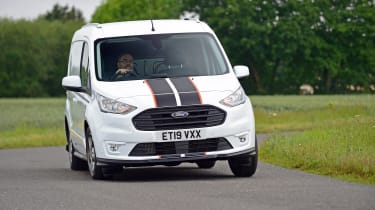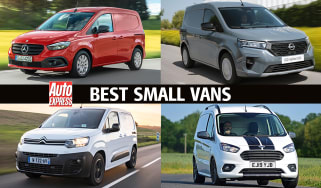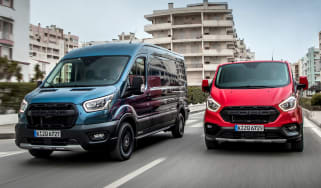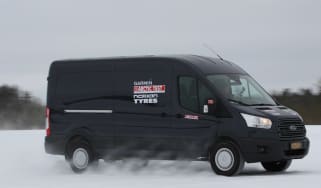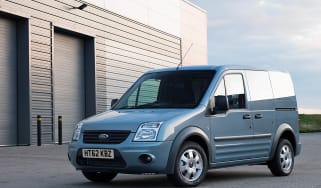Ford Transit Connect van review
The Transit Connect offers car-like handling and road manners, with a decent load capacity and lots of available tech
Ford has taken the Transit name and now created a family of vans, and the Transit Connect is for sale at the compact end of the spectrum. It lines up next to the even smaller Transit Courier as the van of choice if you need something compact, but still with a decent amount of space inside.
The van uses the same platform as the Mk2 and Mk3 Ford Focus, so that means this is a van that's a surprising amount of fun to drive. Even better, a facelift in 2018 introduced more efficient 1.5 EcoBlue diesel engines, improved exterior looks and in-car tech borrowed from Ford's passenger cars.
This combination of sharp driving and decent tech means the Transit Connect is competitive in the small van sector. The association with the Transit name gives the Connect a boost, while the wide range of variants on offer mean there's a van to suit most requirements.
About the Transit Connect
This combination of sharp driving and decent tech means the Transit Connect is competitive in the small van sector. It needs to be, because it has some serious rivals in the shape of the Volkswagen Caddy, Citroen Berlingo, Vauxhall Combo, Peugeot Partner and Fiat Doblo, among others. However, the association with the Transit name gives the Connect a boost, while the wide range of variants on offer mean there's a van to suit most requirements.
More reviews
Like most vans in this class, the Transit Connect comes as a panel van in L1 and L2 lengths, but there's just a single roof height. All vans get a single sliding side door on the nearside (a second door is available as an option), while at the back are a pair of barn doors with a 50:50 split. All Transit Connects feature a slimline steel bulkhead, while two seats are found in the cabin. This can be upgraded to a dual seat with a through loading facility, although the two-passenger seat layout is cramped for all on board.
The Double Cab In-Van variant has a second row of seats and can carry five people, although it still has solid steel side doors (fixed glazing is available as an option), while a movable steel mesh bulkhead is standard. If passenger carrying is your priority, then the Tourneo Connect is the dedicated passenger version of the Transit Connect. It's fully glazed, comes with five or seven seats and has a more car-like interior, with carpets throughout and additional soundproofing.
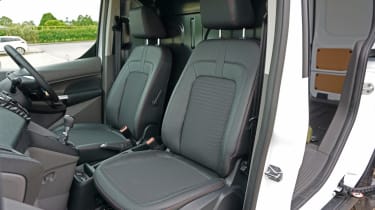
In the engine bay, the Ford Transit Connect uses Ford's latest Euro 6-compliant 1.5 EcoBlue diesel in 75PS, 100PS and 120PS guises. All versions come with a six-speed manual, while the 100 and 120 versions can both be had with an eight-speed auto. If you don't want diesel, then Ford’s 1.0 EcoBoost 100PS turbo petrol is available with a six-speed manual gearbox, although it's only available in more basic trims. Few van buyers will be tempted away from diesel, but for light-duty urban work, the tiny turbo petrol can make sense. All vans are front-wheel drive, although you can add a mechanical limited-slip diff and all-season tyres to all models if you need a bit more traction.
The entry point to the Transit Connect range is Leader trim. This model has black plastic bumpers and steel wheels outside, but does at least feature a DAB radio with Bluetooth phone connectivity, remote central locking, multifunction steering wheel and trip computer, as well as basic safety kit. Trend models feature body coloured bumpers and plastic wheel trims, plus electric heated wing mirrors and Ford's excellent Quickclear windscreen, a glovebox and USB connection.
Limited adds alloy wheels, air-con, auto lights and wipers, keyless starting, rear parking sensors and an alarm among other kit. At the top of the range, the Sport model features twin body stripes, alloy wheels, climate control and part-leather seats, while the Active model introduces off-road inspired styling and Ford's SYNC 3 touchscreen infotainment as standard. These trims all relate to the L1 and L2 panel vans: the Double Cab In-Van only comes in Leader and Trend specs, although it does feature twin sliding side doors as standard.
MPG, CO2 and Running Costs
The worst performer in WLTP-rated fuel economy tests is the EcoBoost 100 petrol engine. Spec that engine with the longer, heavier L2 body, and it records a high of 45.6mpg. The L1 version manages a best of 46.3mpg, but these two are well behind the EcoBlue diesels overall. Go for a diesel, and top-rated WLTP fuel economy is in the region of 61-63mpg, with the 75, 100 and 120 versions all delivering similar figures. Add the 8-speed auto to the 100 or 120 versions and fuel economy is 57-58mpg.
While Ford used to offer the option of a Fuel Economy pack and a lean Transit Connect ECOnetic model, stop-start is now standard with every engine. Options such as speed limiters (at 50, 62 and 70mph) and acceleration control are available to help fleet users save money on fuel, too. All Transit Connect models get the same 60-litre fuel tank, giving a long range between fill-ups. And in case drivers spend so long away from the pumps that they forget which fuel to put in, Ford’s Easy-Fuel anti-misfuelling filler cap is standard. Service intervals for the van are every year or 20,000 miles.
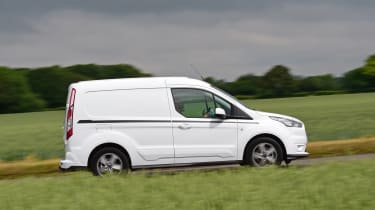
Prices for the Transit Connect start from less than £17,000, with the longer L2 body adding around £1,200 to the list price. Trend trim is around £800 more than Leader, and you can spec all four engines in both trims. Limited trim starts from around £20,000, chiefly because it's only offered with the high-power 1.5 EcoBlue 120 diesel, as are Sport and Active trims. Those two are around £1,600 and £1,700 more than Limited trim, while going for L2 over the L1 body is around £1,500 extra. Adding an auto box bumps the price by around £1,200.
The five-seat Double Cab In-Van range is priced from £18,000 to £22,000, but only comes in Leader and Trend trims. Don't think of it as a budget MPV, though: it still has solid steel sliding side doors and a steel mesh bulkhead, so is pretty basic.
Load Space and Practicality
The entry-point to the Ford Transit Connect range is the L1 van, which offers a 2.9 cubic metre load volume and payloads ranging from 579-718kg, depending on engine and gearbox combination.
The larger L2 model extends the load length from 1,753mm to 2,153mm and offers a 3.6 cubic metre load volume. Maximum payloads for the L2 are slightly higher at 853-876kg, again depending on which running gear you choose.
The Transit Connect’s payload capacities are reasonable, but some versions of rivals such as the Citroen Berlingo and Fiat Doblo can carry more than a tonne, while their cargo volumes can be higher, too.
However, Ford is keen to point out that even the L1 version can carry two Europallets and take 3-metre long items loaded diagonally. The L2 can take 3.4-metre long items with the aid of the optional Loadthrough bulkhead (which also comes with the dual passenger seat) and 8’x 4’ sheets of plasterboard in the load area itself.
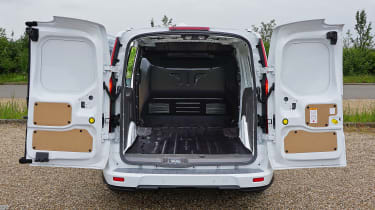
The bulkhead in the Transit Connect is slightly unusual in that it features a pronounced bulge going back into the load area. This reduces load volume but boosts space in the cab and gives you a handy point to rest those diagonally-stowed 3m long planks.
Access is good, with all models getting 50:50 split back doors that lock at 90 degrees and fully open to 180 degrees, plus there's a kerbside sliding side door. Access upgrades include adding an offside sliding door, while the rear doors can be replaced with a glazed top-hinged tailgate. Ford also offers glazing for all doors and for the the bulkhead. A full-width and height solid steel bulkhead is standard, while the Loadthrough hatch with its accompanying dual front passenger seat is an option on all models.
Reliability and Safety
In common with its more advanced contemporaries, the Ford Transit Connect is available with a raft of hi-tech safety kit, but you have to pay for it. In standard guise you get all the basics, including ESC stability control that adapts to the load on board and a driver’s airbag but there’s also Hill Start Assist and Emergency Brake Assist.
Unfortunately, the majority of the Transit Connect's safety kit is on the options list. Delve into it and it’s possible to specify Ford’s Active City Stop, which detects impending accidents and automatically applies the brakes to avoid them.
Other optional kit includes Speed Assist with traffic sign recognition, adaptive cruise control, lane assist, front and rear parking sensors, a rear camera which insets the image into the rear-view mirror, active park assist and blind spot recognition.
Unlike some vans, the Transit Connect only has a single driver's airbag, with a passenger airbag available as an option, while side-impact airbags are included with one of the dual passenger seat upgrades.
Security
All models get central locking with auto relocking that secures the doors if none are opened after 45 seconds. Powered deadlocks and an immobiliser are also standard, while configurable locking allows you to set which doors lock and unlock with each press of the remote key fob. Limited models and above feature a Thatcham Cat 1 perimeter alarm, and this can be added to other variants at extra cost.
Driving and Performance
Ford has managed to inject the whole of the Transit van range with the same responsive, composed handling that has made its passenger cars such a joy to drive over recent years.
The Transit Connect is no exception to this, thanks to its running gear which is shared with the Focus Mk3. There's accurate, well weighted steering and impressive body control, which helps make it one of the best vans in the class to drive. The unladen ride is on the firm side, but the suspension takes the edge off the bumps with impressive suppleness and never becomes crashy, even over major craters in the surface.

The diesel engine is strong too, although not quite as outstanding in the class as the driving dynamics. The 1.5 EcoBlue packs a punch in top-spec 120 guise, and the six-speed gearbox boosts its flexibility, too.
Most buyers will be happy with the 75 (74bhp) or 100 (99bhp) diesels, which both offer decent mid-range shove and are boosted by Ford's snappy six-speed manual gearbox. Go for a top-spec Transit Connect in Limited, Sport or Active trims, and the 118bhp diesel is your only option, and is a punchy performer. Overall, the Transit Connect is a fantastic van to drive, and offering Sport trim is definitely appropriate.
Cab and Interior
Inside the Transit Connect is a roomy two-seater cabin with an abundance of headroom and some clever storage options. Much of the switchgear will be familiar to Ford Fiesta and Focus passenger car owners, and the chunky, angular design theme is carried over from the exterior.
The steering wheel is compact and feels good in your hands with well-positioned controls mounted on it. The cluster of buttons on the original Transit Connect has been replaced by a touchscreen on higher spec facelifted models. Build quality is sturdy throughout, with tough, durable plastics favoured over fancy trim finishes that may not stand the test of time.
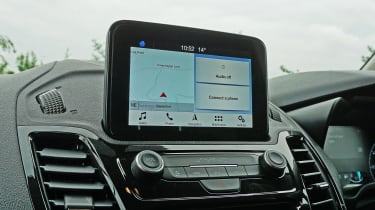
Storage in the cab is good too, with the large overhead shelf combining with door pockets, a glovebox, a central storage area between the seats and a handy lidded cubby above the dials to provide plenty of options for keeping the cab tidy. The Transit Connect has a flexible dual passenger seat option, with the middle seat able to flip up to provide extra storage or fold down to create a writing desk. However, it's not that spacious when used as a seat – shoulder and hip space is very tight for all three occupants across the cabin.
Van dimensions
| Body style | Height | Width | Length |
| L1 Short wheelbase van | 1,830mm | 1,835mm | 4,425mm |
| L2 Long wheelbase van | 1,828mm | 1,835mm | 4,825mm |
| L1 Double Cab In-Van | 1,819mm | 1,835mm | 4,425mm |
| L2 Double Cab In-Van | 1,820mm | 1,835mm | 4,825mm |
Load area dimensions
| Body style | Height | Width | Length | Volume |
| L1 Short wheelbase van | 1,269mm | 1,543mm | 1,786mm | 2.9m3 |
| L2 Long wheelbase van | 1,269mm | 1,496mm | 2,152mm | 3.6m3 |
| L1 Double Cab In-Van | 1,237mm | 1,533mm | 861mm | 1.2m3 |
| L2 Double Cab In-Van | 1,267mm | 1,496mm | 1,061mm | 1.6m3 |
(Width between wheel arches van/DCIV: 1,249/1,193mm)

